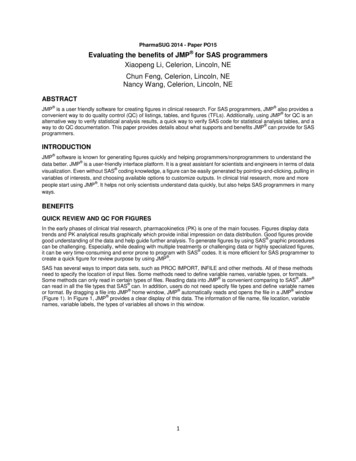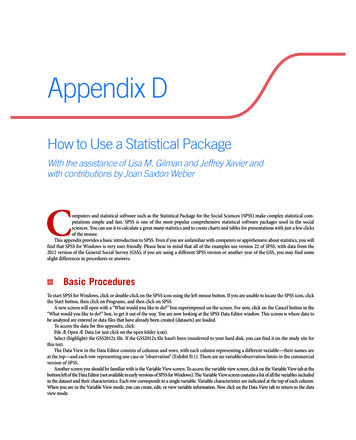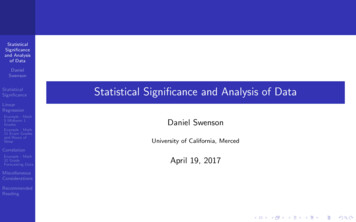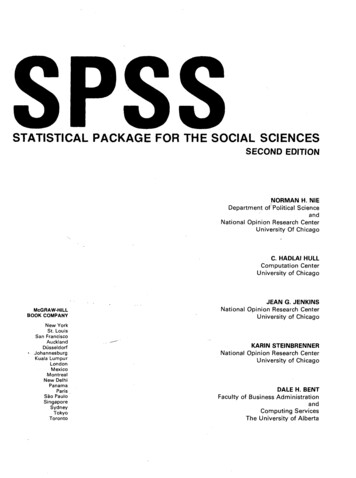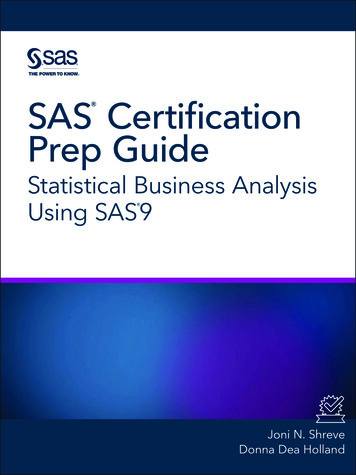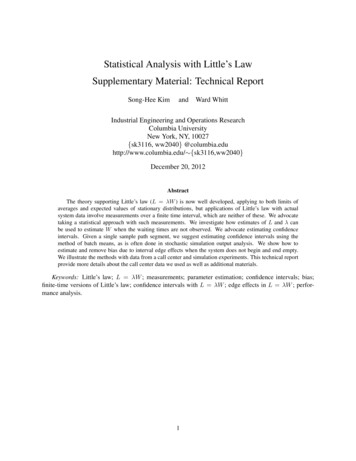
Transcription
Statistical Analysis with Little’s LawSupplementary Material: Technical ReportSong-Hee KimandWard WhittIndustrial Engineering and Operations ResearchColumbia UniversityNew York, NY, 10027{sk3116, ww2040} @columbia.eduhttp://www.columbia.edu/ {sk3116,ww2040}December 20, 2012AbstractThe theory supporting Little’s law (L λW ) is now well developed, applying to both limits ofaverages and expected values of stationary distributions, but applications of Little’s law with actualsystem data involve measurements over a finite time interval, which are neither of these. We advocatetaking a statistical approach with such measurements. We investigate how estimates of L and λ canbe used to estimate W when the waiting times are not observed. We advocate estimating confidenceintervals. Given a single sample path segment, we suggest estimating confidence intervals using themethod of batch means, as is often done in stochastic simulation output analysis. We show how toestimate and remove bias due to interval edge effects when the system does not begin and end empty.We illustrate the methods with data from a call center and simulation experiments. This technical reportprovide more details about the call center data we used as well as additional materials.Keywords: Little’s law; L λW ; measurements; parameter estimation; confidence intervals; bias;finite-time versions of Little’s law; confidence intervals with L λW ; edge effects in L λW ; performance analysis.1
Contents1Introduction and Overview32More on the Call Center Data2.1 The Data Available and Used . . . . . . . . . . .2.2 Statistics from Eighteen Weekdays in May, 20012.2.1 The Hourly Arrival Rates . . . . . . . . .2.2.2 The Hourly Average Waiting Times . . .2.2.3 The Hourly Average Number in System .3An Alternative Way to Construct the Confidence Intervals4More on Bias4.1 Bias in the Estimator W̄ (t) in a Stationary Setting4.2 More on the Bias Due to Interval Edge Effects . .4.2.1 Large-Time Stationary Asymptotics . . .4.2.2 The Single-Server Paradigm . . . . . . .4.2.3 The Infinite-Server Paradigm . . . . . . .34566712.1213131315165A New Algorithm to Estimate Confidence Intervals by Batch Means176Supplementary Tables202
1Introduction and OverviewIn the main paper and associated e-companion Kim and Whitt (2012), we advocate taking a statisticalapproach with the finite-time version of Little’s law for measurements from a finite time interval and showhow it can be done. The importance of a finite-time perspective was emphasized by Buzen (1976), Denningand Buzen (1978) and Little (2011), but they advocated the altered definitions in §2.3 of the main paperproducing an equality relation. In contrast, like Mandelbaum (2011), we emphasize the importance of themore complex relation in Theorem 2 of the main paper, because we think it is more informative.The main contribution here is the emphasis on statistics. Even though statistics is not customarily usedwhen applying Little’s law with data over a finite time interval, there is a large literature on statisticalanalysis for call centers and queueing models, more generally. For call centers, statistical methods playan important role in forecasting, as illustrated by Aldor-Noiman et al. (2009) and references therein. Forqueueing models, many papers focus on statistics, including inference with limited data, as illustrated byHansen and Pitts (2006) and Larson (1990).In §2 we present additional information about the call center data used. In §3 we discuss another wayto do the confidence intervals using the method of batch means. In §4 we elaborate on the bias discussedin §5 of the main paper, discussing the bias in the estimator W̄ (t) in (1) (in the main paper) for W in astationary setting in §4.1. In §4.2 we discuss the bias in the alternative estimator W̄L,λ (t) in (3) of the mainpaper for E[W (t)] in a nonstationary setting and W in a stationary setting. In both cases, we focus on themany-server and single-server paradigms in order to highlight important model-dependent properties. In §5we introduce an alternative algorithm to estimate confidence intervals in approximately stationary intervalsby batch means, exploiting Theorem 2 of the main paper. However, this algorithm did not improve theestimation for the call center example, so we do not emphasize it. The negative result itself is interesting,because it is natural to consider such alternatives. It remains to be seen if the new algorithm can be usefulin other contexts. Finally, in §6 we present additional figures and tables.2More on the Call Center DataIn this section, we provide more details about the call center data we used. As explained in the mainpaper, the data are from a telephone call center of a medium-sized American bank from the data archiveof Mandelbaum Mandelbaum (2012), collected from March 26, 2001 to October 26, 2003. This bankingcall center had sites in New York, Pennsylvania, Rhode Island, and Massachusetts, which were integratedto form a single virtual call center. The virtual call center had 900 1200 agent positions on weekdays and200 500 agent positions on weekends. The center processed about 300, 000 calls per day during weekdays,with about 60, 000 (20%) handled by agents, with the rest being served by integrated voice response (IVR)technology. As in many modern call centers, in this banking call center there were multiple agent types andmultiple call types, with a form of skill-based routing (SBR) used to assign calls to agents.Since we were only concerned with estimation related to the three parameters L, λ and W , we didnot get involved with the full complexity of this system. Specifically, we used data for only one class ofcustomers, denoted by Summit. Furthermore, among them, only the sub-calls that had agent interactionsduring weekdays in May 2001 were considered.The rest of this supplement is organized as follows. In §2.1 we briefly describe the full database ofMandelbaum Mandelbaum (2012) and how we extracted the required data in order to produce the resultsin the main paper. In §2.2 we describe the statistics collected for the 18 weekdays in May we used in ouranalysis and give an overview of the statistics.3
2.1The Data Available and UsedThe full database of Mandelbaum (2012) provides nine pre-processed ACCESS tables for each day in thestudy period, from March 26, 2001 to October 26, 2003. In the pre-processing, issues such as midnight calls,incorrect time stamps and incorrect identifiers (id’s) are already taken care of. As shown on the left pane ofFigure 1, the nine database tables are titled: calls, customer sub-calls, server sub-calls,queue records, event details, agent events, agent profile, agent records, andagent shifts. The calls table includes general information on each call that enters the call centeron a particular day. Each call then consists of sub-call(s) that start and end with a particular service suchas IVR, agent interaction and announcement. We focus on the sub-calls of Summit customers that involveagent interaction, and hence use only the customer sub-calls table of each day.Figure 1: Example of ACCESS tables: call center data from May 25, 2001.Figure 1 is an example of the customer sub-calls table. There are 23 fields in the table, whichare: call id, cust subcall, server subcall, record id, node, customer id, customer type, service group,service, f irst service, segment start, queue exit, service entry, segment end, seg type, outcome,seg parties, wait time, queue time, preservice wait, service time, hold time, and party answered.More information about the different tables, including detailed descriptions of each field, can be found el Description and Introduction to User Interface.pdfTo create the data set we used in Kim and Whitt (2012), we used the following steps: Each sub-call is served by a service group. There are five main service groups, which are IVR, Business line, non-Business line, Announcement and Message. We kept the sub-calls that were handled bythe Business line (service group 2). In the ACCESS customer sub-calls table, we filteredout these sub-calls by selecting service group 2, as illustrated in Figure 1. We kept the sub-calls that are from Summit customers by keeping records with service 14 (Theservice field indicates the type of service received by the caller. For example, there are Retail 1,P remier 2, Business 3 and P latinum 4).4
We dropped the records with no agent interaction, which involve the caller hanging up (abandoning)while waiting to speak to the next agent. This was done by dropping records with outcome 11, 12,or 13. The outcome field indicates the cause of call termination such as whether they were handled,transferred and abandoned. outcome 11 indicates the customer abandoned short (the caller abandons within an abandon threshold time), outcome 12 indicates the customer abandoned (after theabandon threshold time) and outcome 13 indicates the call was not handled with other reason thatis not specified in the data). To ensure that each sub-call spent positive amount of time with an agent, we omitted records withservice time 0, where service time is defined as the sum of talk time and hold time. It can alsobe defined as the difference between segment end and service entry. Since we already dropped therecords with customer abandonment, there were not many records with service time 0, less than5 for each day. In order to compute the three parameters L, λ and W , we used the time each sub-call enters thequeue, leaves the queue (hence enters the service) and leaves the service. Therefore, we kept onlythe fields call id, segment start (queue entry time), queue exit (queue exit time), service entry(service entry time) and segment end (service exit time). (The time stamps are records in seconds,using the origin time, 00:00:00 on 01/01/1970. Finally, we exported the table to an EXCEL file using the “Export to Excel spreadsheet” function.The steps above were carried out by the authors for 18 weekdays of May. (In the next section we explainhow the 18 days were selected.) The combined data set for all 18 weekdays (little weekdays in M ay.xls)is available from the authors’ web sites.2.2Statistics from Eighteen Weekdays in May, 2001There were 23 weekdays in May 2001. (May 1, 2001, was a Tuesday.) Four weekdays were not normal, andso were excluded, for the following reasons: May 9 (Wed): shutdown from 4:53:10 AM until 11:28:54 AM May 10 (Thurs): shutdown from 2:59:18 PM until 11:31:24 PM May 28 (Mon): Memorial Day May 31 (Thurs): data missingIn addition, the data from May 3 were excluded because the number of arrivals was extraordinarily high.In particular, the number of arrivals was 8310 on May 3 with about 50% arriving before 9 AM, whereasfor the other 18 weekdays, the average number of arrivals was 5410.5 arrivals, with a standard deviation1080.5. For each day, there were data over a 17-hour period, from 6 AM to 11 PM, referred to as [6, 23].(There were no arrivals before 6 AM and after 11 PM.)We primarily focused on the number of Summit customers in the system, but we also considered whetherthey were in service or waiting (in queue). Thus we measured the numbers in the system, in service and inqueue. Similarly, we measured the time that each customer spent in the system, in the queue and in service.Using the data set little weekdays in M ay.xls, we collected the following statistics: Lsys : the number in system Lser : the number in service5
Lq : the number in queue Asys Aq : number of arrivals into the system/queue Aser : number of arrivals into service Wsys : time spent in the system Wser : time spent in service Wq : time spent in queueThese are understood to be functions of the measurement interval. For example, Asys Asys ([9, 10]) is thenumber of arrivals into the system during the interval [9, 10]. For the interval [9, 10], the average arrival rateper minute isAsys ([9, 10])Asys ([9, 10]) ,(1)λ̄(t) m([9, 10])60where m([9, 10]) 60 is the number of minutes in the interval [9, 10]. Thus the statistics are consistentwith the definitions in equation (1) of Kim and Whitt (2012).2.2.1The Hourly Arrival RatesFigure 2 shows the overall average (over the full 17-hour day) and the hourly averages of the arrival rates perminute, as defined in (1), together with estimates of the 95% confidence interval (treating the daily values asi.i.d. Gaussian variables) for the 18 weekdays in May. Figure 2 shows that the arrival rate is nonstationaryover the day. Figure 2 also shows that the arrival rate is highly variable from day to day, because of thewide confidence intervals for the hourly averages. Part of this day-to-day variation can be explained byday-of-week effect. Figure 3 shows that the average call volume on Mondays is the largest, followed by thatof Tuesdays, and then the others. Figures 4-8 further illustrate day-to-day variation in the same day of week.2.2.2The Hourly Average Waiting TimesFigures 9-11 show the overall average (average of the 18 daily averages) and hourly average of the waitingtime in the system, service and queue and their 95% confidence interval of 18 weekdays in May. Figure 10suggests that the service times are approximately stationary over time. However, by comparing Figure 10 toFigure 9, we can conclude that it is hard to say that the times in system is approximately equal to the servicetimes because the time in queue is too long in the interval [17,20], which might be due to inadequate staffingduring this interval. Furthermore, Figure 11 suggests the waiting times in system is not approximatelystationary over time, again possibly due to inadequate staffing.Next, Figure 12 shows the histogram of all waiting times in the interval [10, 16] of Friday, May 25, 2001in our call center example. In addition, Figure 13 and Figure 14 illustrate the histograms of all waitingtimes and service times in the interval [9, 17] over 18 weekdays in May in our call center example. As usualfor call centers, the distribution is approximately lognormal, but the SCV very close to 1 indicates that anexponential approximation is reasonable.6
12Overall AvgHourly Avg of λarrival rate per minute10864206 7 8 9 10 11 12 13 14 15 16 17 18 19 20 21 22 23tFigure 2: Overall average and hourly average of λ and its 95% confidence interval over 18 weekdays inMay.2.2.3The Hourly Average Number in SystemFigures 15-17 show the overall average (average of the 18 daily averages) and hourly average number inthe system, service and queue and their 95% confidence interval of 18 weekdays in May. We observe thatthe number in system is approximately equal to the number in service, except at the times when there areslightly longer queues, in the intervals [9,13] and [17,20].7
1412MonTuesWedThursFri16average arrival rate per minuteaverage arrival rate per minute161086414Monday AvgMay 7May 14May 2112108642206 7 8 9 10 11 12 13 14 15 16 17 18 19 20 21 22 23t06 7 8 9 10 11 12 13 14 15 16 17 18 19 20 21 22 23tFigure 3: Average arrival rate and the day-ofweek effect in May.Figure 4: Average arrival rate of Mondays inMay.1412Tuesday AvgMay 1May 8May 15May 22May 2916average arrival rate per minuteaverage arrival rate per minute16108641412Wednesday AvgMay 2May 16May 23May 30108642206 7 8 9 10 11 12 13 14 15 16 17 18 19 20 21 22 23t06 7 8 9 10 11 12 13 14 15 16 17 18 19 20 21 22 23tFigure 5: Average arrival rate of Mondays inMay.Figure 6: Average arrival rate of Wednesdays inMay.14Thursday AvgMay 17May 2416average arrival rate per minuteaverage arrival rate per minute1612108641412Friday AvgMay 4May 11May 18May 25108642206 7 8 9 10 11 12 13 14 15 16 17 18 19 20 21 22 23t06 7 8 9 10 11 12 13 14 15 16 17 18 19 20 21 22 23tFigure 7: Average arrival rate of Thursdays inMay.Figure 8: Average arrival rate of Fridays in May.8
time spent in the system, min7654321Overall AvgHourly Avg of Wsys06 7 8 9 10 11 12 13 14 15 16 17 18 19 20 21 22 23tFigure 9: Overall average and hourly average of Wsys and its 95% confidence interval over 18 weekdays inMay.time spent in the service, min43Overall AvgHourly Avg of Wser26 7 8 9 10 11 12 13 14 15 16 17 18 19 20 21 22 23tFigure 10: Overall average and hourly average of Wser and its 95% confidence interval over 18 weekdaysin May.time spent in the queue, min4Overall AvgHourly Avg of Wq32106 7 8 9 10 11 12 13 14 15 16 17 18 19 20 21 22 23tFigure 11: Overall average and hourly average of Wq and its 95% confidence interval over 18 weekdays inMay.9
120100µ 3.382frequency80σ 3.411c2 1.0176040200051015202530time spent in the system (minutes)35Figure 12: The histogram (empirical distribution) of the times spent in the system of all arrivals during theinterval [10, 16].500030002000300020001000100000µ 3.415σ 3.5812c 1.0994000Frequency4000Frequency5000µ 3.608σ 3.617c2 1.005510152025time spent in the system, min300035Figure 13: The histogram (empirical distribution) of the times spent in the system of all arrivals during the interval [9, 17] over 18 weekdays in May (n 72, 535 and 41 observationsthat had Wsys 35 are not represented).510152025time spent in service, min3035Figure 14: The histogram (empirical distribution) of the times spent in service of all arrivalsto the service during the interval [9, 17] over 18weekdays in May (n 72, 494 and 39 observations that had Wser 35 are not represented).10
40Overall AvgHourly Avg of Lsys35number in system3025201510506 7 8 9 10 11 12 13 14 15 16 17 18 19 20 21 22 23tFigure 15: Overall average and hourly average of Lsys and its 95% confidence interval over 18 weekdays inMay.40Overall AvgHourly Avg of Lser35number in service3025201510506 7 8 9 10 11 12 13 14 15 16 17 18 19 20 21 22 23tFigure 16: Overall average and hourly average of Lser and its 95% confidence interval over 18 weekdays inMay.87Overall AvgHourly Avg of Lqnumber in queue65432106 7 8 9 10 11 12 13 14 15 16 17 18 19 20 21 22 23tFigure 17: Overall average and hourly average of Lq and its 95% confidence interval over 18 weekdays inMay.11
3An Alternative Way to Construct the Confidence IntervalsIn §4.3 of the main paper, we discuss how to construct confidence intervals for the indirect estimator of thewaiting time using the method of batch means. In that procedure, we first compute W̄L,λ,k (t, m), which arethe batch analogs of the relations in (3) of the main paper, and then directly compute the sample mean andvariance based on the batches. An alternative way is to use the average of direct estimate values. That is,we can usemm1 X1 XL̄(m) (t) Lk (t, m) and λ̄(m) (t) Ak (t, m)(2)m k 1mt k 10 (t) L̄(m) (t)/λ̄(m) (t) (via the relation in (3) of the main paper) and the varianceto construct the mean W̄λ,Lvia the first equation in (35) of the main paper. Table 1 demonstrates that we get similar results from the twodifferent methods, and that both indirect methods provide reasonable estimates.Table 1: Direct estimates of W from (1) in the main paper plus two indirect estimates using the formulasin (3) of the main paper. Both indirect estimates are constructed using the method of batch means withm 5, 6, ., 20 batches for the call center data for the time intervals [10, 16] and [14, 15]. W̄λ,L (t) is0 (t) is computed using the average ofcomputed using the batch analogs of the relations in (3) whereas W̄λ,Ldirect estimate values.[10, 16]4[14, 15]mW̄ (t)W̄λ,L (t)0W̄λ,L(t)5678910111213141516171819203.38 0.223.39 0.253.39 0.203.39 0.193.39 0.173.39 0.153.39 0.143.39 0.163.39 0.133.39 0.153.39 0.163.39 0.143.39 0.133.39 0.133.39 0.133.39 0.153.38 0.193.38 0.233.38 0.173.38 0.213.38 0.173.38 0.163.38 0.153.38 0.153.38 0.113.38 0.143.38 0.143.39 0.163.38 0.143.38 0.133.39 0.143.38 0.113.37 0.203.37 0.223.37 0.173.37 0.213.37 0.173.37 0.163.37 0.153.37 0.153.37 0.123.37 0.143.37 0.143.37 0.153.37 0.143.37 0.133.37 0.143.37 0.11W̄ (t)W̄λ,L (t)0W̄λ,L(t)3.33 0.213.32 0.183.34 0.193.34 0.223.32 0.243.33 0.213.32 0.213.32 0.183.33 0.203.35 0.203.29 0.253.36 0.243.31 0.223.30 0.223.33 0.203.32 0.233.33 0.103.33 0.093.36 0.293.35 0.263.34 0.183.34 0.163.38 0.293.34 0.163.37 0.233.38 0.283.39 0.273.37 0.233.40 0.323.42 0.313.38 0.213.43 0.313.32 0.103.32 0.093.32 0.243.32 0.253.32 0.173.32 0.163.32 0.263.32 0.153.32 0.243.32 0.233.32 0.243.32 0.223.32 0.253.32 0.243.32 0.213.32 0.25More on BiasIn two subsections here we elaborate on the bias discussed in §5 of the main paper, discussing the bias inthe estimator W̄ (t) for W in a stationary setting in §4.1 and the bias of the alternative estimator W̄L,λ (t) in(3) of the main paper for E[W (t)] in a nonstationary setting in §4.2In both cases it is important to know more about the underlying model. As in §5 of the main paper, wesee that the situation is very different for many-server and single-server models. Just as it is good to have12
the averages in (1) of the main paper over multiple time intervals, so that we can check for stationarity, it isalso good to be able to probe more fully into the model. It can be very helpful to understand if the systemcan be approximately represented as the many-server paradigm, the single-server paradigm or neither ofthese. For the single-server paradigm, it is helpful to understand the service-time distribution as well as thewaiting-time distribution.If we are considering indirect estimation of E[W̄ (t)], it is good to have some rough understandingabout the waiting times. Are successive waiting times approximately stationary? Are successive waitingtimes approximately independent? Can the distribution of the waiting times be regarded as approximatelyexponential? Are the waiting times (times in system) nearly the same as the service times or are they muchgreater?4.1Bias in the Estimator W̄ (t) in a Stationary SettingIn §5 of the main paper we noted that, in general, the estimator W̄ (t) in (1) of the main paper is a biasedestimator of W in a stationary setting, because the mean E[W̄ (t)] is the expected value of the ratio oftwo random variables. If we specify the underlying queueing model, then we can analyze that bias. As in§5 of the main paper, the model makes a big difference. For additional background on estimation in themany-server and single-server settings, see Srikant and Whitt (1996) and Whitt (1989).4.2More on the Bias Due to Interval Edge EffectsIn §5 of the main paper we observed that if the special condition L(t) R(0) 0 does not hold, thenW̄L,λ (t) is typically a biased estimator of E[W (t)] and we discussed various alternative estimators designedto remove that bias.In this section we investigate the extent of the bias in the alternative estimator W̄L,λ (t). We measure therelative error by the relative root mean square error (RMSE) and the expected relative errorpRM SEW (t) E[ W (t)2 ]E[W (t)]and relW (t) E[ W (t) ].E[W (t)](3)For a service system with a daily cycle, like the example in §3 of the main paper, where the numberin system builds up to its steady-state level during the early morning and then later declines at the end ofthe day, we anticipate that L(t) R(0) at the beginning of the day, while L(t) R(0) at the end of theday. Thus we can anticipate the sign of the error ( W (t) W̄L,λ (t) W̄ (t)) during these non-stationaryperiods; i.e., we can anticipate that W (t) 0 during initial periods and W (t) 0 during final periods.To illustrate, for the call center example in §3 of the main paper, L(t) R(0) for 7 of the 8 half hourintervals in [6, 10], 6 of the 14 half hour intervals in [10, 17], and 2 of the 12 half hour intervals in [17, 23];while W (t) 0 for 6 of the 8 half hour intervals in [6, 10], 6 of the 14 half hour intervals in [10, 17], and3 of the 12 half hour intervals in [17, 23]. See Table 2 for more details.To roughly quantify the potential benefit from refined estimation, consider the stationary M/GI/ model with E[S] 1 and arrival rate λ, starting empty. Formula (20)of Eick et al. (1993) implies thatRE[W (t)] E[L(t)] λGe (t). Hence, E[W̄ (t)] E[L̄(t)] (λ/t) 0t Ge (s) ds. If we approximate A(t)in the denominator of W (t) be λt, then E[ W (t)] Ge (t)/t, which is small compared to E[W̄ (t)] ifeither λ or t is large, but can be significant if neither is large.4.2.1Large-Time Stationary AsymptoticsFor a fixed measurement interval [0, t], there is a relatively clear story in a stationary regime when t is largeenough. First, in a stationary regime, we replace E[W (t)] in (3) by W . Let f (t) g(t) as t mean13
Table 2: Comparison of L(t), R(0) and W (t) for the 34 half hour intervals in [6, 23] for the data from §3of the main paper.IntervalL(t)R(0)W̄ (t)W̄L,λ (t) W (t)[06 : 00, 06 : 30][06 : 30, 07 : 00][07 : 00, 07 : 30][07 : 30, 08 : 00][08 : 00, 08 : 30][08 : 30, 09 : 00][09 : 00, 09 : 30][09 : 30, 10 : 00][10 : 00, 10 : 30][10 : 30, 11 : 00][11 : 00, 11 : 30][11 : 30, 12 : 00][12 : 00, 12 : 30][12 : 30, 13 : 00][13 : 00, 13 : 30][13 : 30, 14 : 00][14 : 00, 14 : 30][14 : 30, 15 : 00][15 : 00, 15 : 30][15 : 30, 16 : 00][16 : 00, 16 : 30][16 : 30, 17 : 00][17 : 00, 17 : 30][17 : 30, 18 : 00][18 : 00, 18 : 30][18 : 30, 19 : 00][19 : 00, 19 : 30][19 : 30, 20 : 00][20 : 00, 20 : 30][20 : 30, 21 : 00][21 : 00, 21 : 30][21 : 30, 22 : 00][22 : 00, 22 : 30][22 : 30, 23 : .8710.756.275.844.282.674.595.934.704.47 0.702 0.5170.252 0.337 0.030 0.2920.348 0.2890.067 0.2160.0850.155 0.2110.2800.032 0.074 0.0920.111 0.3240.1440.130 0.4081.4620.076 1.2611.0981.0690.4700.2020.032 2.2301.558 0.2671.509dthat f (t)/g(t) 1 as t . Let mean equal in distribution. The following is an easy consequence of(7) of the main paper.Theorem 4.1 (asymptotic edge effect) If the system is in a stationary environment where L λW is valid(r)(r)with TW (t) asymptotically independent of TW (0) as t , then(r)t W (t) W (r)TW,1 TW,2λ14as t ,(4)
(r)(r) d(r)(r)where TW,1 and TW,1 are independent random variables distributed as TW TW (t), so that E[ W ] 0,(r)V ar( W ) 2V ar(TW )/λ2 andpRM SEW (t) qV ar( W (t)) W(r)ar(TW )2VtλWq (r)2V ar(TW )tLas t .(5)Theorem 4.1 implies that the root mean square error (RMSE) given in (5) is asymptotically inverselyproportional to t. The behavior of RM SEW (t) in more detail depends on the specific model. As in §5 ofthe main paper, we gain insight by considering the two idealized queueing models.4.2.2The Single-Server ParadigmConsider the same single-server model as in §5.5 of the main paper. Let c2S V ar(S)/E[S]2 be thesquared coefficient of variation (SCV) of S and similarly for other nonnegative random variables. Let Sr bethe steady-state version of Sr (t), the residual service in process, if any. In steady state, E[Sr ] ρE[Se ] ρE[S](c2S 1)/2 , where ρ λE[S] is the traffic intensity.To understand the implications of Theorem 4.1 in this context, we exploit the conventional heavy-trafficapproximation for the number in system, arising as ρ 1; see Whitt (2002). In particular, this limit tells usthat (i) the first term in (38) of the main paper is asymptotically negligible (relatively) and (ii) L(t) shouldbe approximately exponentially distributed with meanL ρ21 ρ!ca c2S2!,(6)where λc2a is the normalization constant in a central limit theorem for the arrival counting process, with c2abeing the SCV of an interarrival time if the arrival process is a renewal process.Corollary 4.1 (RMSE for the stationary single-server model) In addition to the assumptions of Theorem4.1, assume that the system is a G/GI/1 queue in heavy traffic. ThenV(r)ar(TW ) (12L3 6L2 L)E[S]2 c2S(20L4 16L3 3L2 )E[S]2 64! 5E[S]2 L4(7)for L in (6), with the final approximation including only the leading term in L. Hence, for suitably large ρand t (increasing with ρ),!!! 10E[S]L10E[S]ρ2ca c2SRM SEW (t) .(8)tt1 ρ2Proof. The heavy-traffic condition implies that we can ignore the first term in (38) of the main paper andassume that L(t) is exponential with mean in (6). Thus we can apply the conditional variance formula, p.119 of Ross (2010), to (38) of the main paper without the first term and then the formula for sums of integersand their squares. From the exponential property, E[L(t)k ] k!Lk . We combine Theorem 4.1 and (7) toget the final approximation (8).In contrast, suppose that we choose the interval [0, t] so that L(0) L(t) pL, where 0 p .Then we can replace the random L(t) in (38) of the main paper with the deterministic value pL, p times thedeterministic mean L.15
Corollary 4.2 (reduction in RMSE for the stationary single-server model) In addition to the assumptionsof Corollary 4.1, assume that L(0) L(t) pL. ThenV(r)ar(TW ) (2(pL)3 3(pL)2 (pL)E[S]2 c2S6! E[S]2 c2Sp3 L33(9)for L in (6), where the last expression is the leading term in L. Hence, Hence, for suitably large ρ and t(increasing with ρ),qRM SEW (t) E[S] c2S p3 L3t q c2S E[S]p3/2t ρ2 1 ρ!1/2ca c2S2!1/2.(10)Proof. We follow the proof of Corollary 4.1. Then the second term in (7) does not appear and we need notconsider higher moments in the first term, so that (7) becomes (9). Since the heavy-traffic approximations in (8) and (10) are order O(L)
The virtual call center had 900 1200 agent positions on weekdays and 200 500 agent positions on weekends. The center processed about 300;000 calls per day during weekdays, with about 60;000 (20%) handled by agents, with the rest being served by integrated voice response (IVR) technology. As in many modern call centers, in this banking call .
